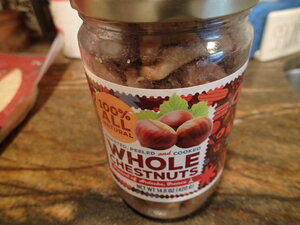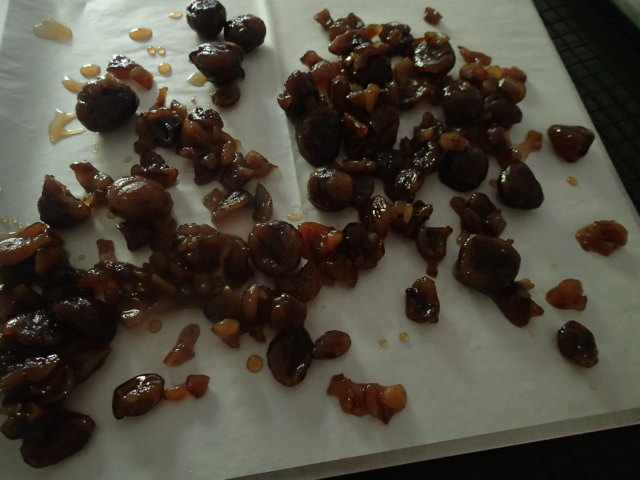This post came about when a bread recipe called for Candied Chestnuts. In the United States of America, Candied Chestnuts are quite pricey. Perhaps around the holidays they are more affordable but, off season, they run over Twenty-five dollars US ($25.00) for a 500 gram jar of the finished product. With that in mind, this author set out to learn how to produce Candied Chestnuts.
From researching online, it appears Candied Chestnuts originated in Turkey. When sugar was introduced into Europe from the Middle East after the Crusades, recipes for the confection started popping up in Northern Italy and in Southern France. Under the French name, Marrons Glaces, they are mentioned in the court of Louis XIV at the palace of Versailles. If you care to know more, here is a link to a deeper dive.
The process to produce Marrons Glaces requires an investment in time. Set aside the proper amount of time if these are needed for another recipe. It takes 4 days to produce this candied confection. Start with raw chestnuts by purchasing a jar of chestnuts that are already shelled, peeled, and cooked. This saves time performing these steps and dealing with sharp implements, and possible cuts to yourself, to shell the nuts to get to the meat.

Bits & Pieces concerning Candied Chestnuts:
- Make sure to bring to a full boil each time.
- At the end, save the leftover liquid. It is delicious in tea or as a topping for pancakes.
- The finished product can be saved in the refrigerator if using within a day or two.
- Make sure to let the Candied Chestnuts stand in the liquid for 24 hours. Each time, they will absorb more liquid.
- Place them in cellophane or candy paper cups if giving as gifts around Christmastime.
Candied Chestnuts
Ingredients
- 14.8 ounce jar – shelled, peeled & cooked chestnuts
- 14.8 ounces – water
- 14.8 ounces – sugar
- 1 – teaspoon – ground cinnamon
- Vanilla bean
Instructions
- 1. Start this process 4 days before you need to use them.
- 2. In a large saucepan, combine water, sugar, cinnamon and vanilla bean.
- 3. Bring the mixture to a boil and then reduce to a simmer. Simmer mixture for 5 minutes.
- 4. Add chestnuts to water-sugar mixture.
- 5. Return to a boil, reduce heat and let simmer for 10 minutes.
- 6. Remove from heat, remove vanilla bean, cover and let stand for 24 hours.
- 7. Using a slotted spoon, remove chestnuts from mixture. (Note: it is okay to leave some small pieces behind.)
- 8. Return sugar mixture to a boil.
- 9. Return the chestnuts to the sugar mixture and boil for 1 minute.
- 10. Remove from heat, cover, an d let stand for 24 hours.
- 11. Repeat steps 7 through 10 2 more times.
- 12. Line a baking sheet with wax or parchment paper.
- 13. Place chestnuts on prepared baking sheet. Leave some space for air to circulate around the chestnuts (don’t crowd them.)
- 14. Heat oven to lowest setting (150°F is ideal, my oven only goes down to 170°F but that seemed to work out fine.)
- 15. Turn off the heat and prop oven door open using a handle of a long ladle or something similar.
- 16. let the chestnuts sit, undisturbed, for an hour to an hour and a half.
- 17. Reserve any leftover liquid from saucepan.
- 18. If not using immediately, store in the liquid and refrigerate.
Nutrition Facts
Candied Chestnuts
Serves: 14
|
Amount Per Serving: 5 chestnuts
|
||
|---|---|---|
| Calories | 248 | |
| % Daily Value* | ||
| Total Fat 0 | 0 | |
| Saturated Fat 0 | 0 | |
| Trans Fat 0 | ||
| Cholesterol 300 | 100% | |
| Sodium 0 | 0 | |
| Total Carbohydrate 60 | 20% | |
| Dietary Fiber 0 | 0 | |
| Sugars 0 | ||
| Protein 2 | ||
| Vitamin A 0 | Vitamin C 0 | |
| Calcium 0 | Iron 0 | |
* Percent Daily Values are based on a 2,000 calorie diet. Your daily values may be higher or lower depending on your calorie needs.
Learning to Bake


